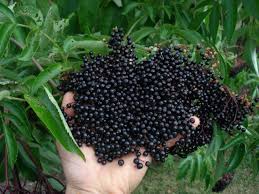 American Elderberry Sambucus Canadensis
American Elderberry Sambucus Canadensis
- Flowers provide nectar for many native pollinators.
- The fruit is favored by birds and other wildlife.
- Excellent for naturalizing in moist soil.
- Easy to grow.
- Fruit is perfect for jams and jellies.
Used for its antioxidant activity, to lower cholesterol, improve vision, boost the immune system, improve heart health and for coughs, colds, flu, bacterial and viral infections and tonsilitis. Elderberry juice was used to treat a flu epidemic in Panama in 1995.
Elderberries have been a folk remedy for centuries in North America, Europe, Western Asia, and North Africa, hence the medicinal benefits of elderberries are being investigated and rediscovered. Elderberry is used for its antioxidant activity, to lower cholesterol, to improve vision, to boost the immune system, to improve heart health and for coughs, colds, flu, bacterial and viral infections and tonsilitis. Bioflavonoids and other proteins in the juice destroy the ability of cold and flu viruses to infect a cell. People with the flu who took elderberry juice reported less severe symptoms and felt better much faster than those who did not. Elderberry juice was used to treat a flu epidemic in Panama in 19951
Elderberries contain organic pigments, tannin, amino acids, carotenoids, flavonoids, sugar, rutin, viburnic acid, vitaman A and B and a large amount of vitamin C. They are also mildly laxative, a diuretic, and diaphoretic. Flavonoids, including quercetin, are believed to account for the therapeutic actions of the elderberry flowers and berries. According to test tube studies2 these flavonoids include anthocyanins that are powerful antioxidants and protect cells against damage.

Elderberries were listed in the CRC Handbook of Medicinal Herbs as early as 1985, and are listed in the 2000 Mosby's Nursing Drug reference for colds, flu, yeast infections, nasal and chest congestion, and hay fever. In Israel, Hasassah's Oncology Lab has determined that elderberry stimulates the body's immune system and they are treating cancer and AIDS patients with it. The wide range of medical benefits (from flu and colds to debilitating asthma, diabetes, and weight loss) is probably due to the enhancement of each individual's immune system.
At the Bundesforschungsanstalt research center for food in Karlsruhe, Germany, scientists conducting studies on Elderberry showed that elderberry anthocyanins enhance immune function by boosting the production of cytokines. These unique proteins act as messengers in the immune system to help regulate immune response, thus helping to defend the body against disease. Further research indicated that anthocyanins found in elderberries possess appreciably more antioxidant capacity than either vitamin E or vitamin C.
Studies at Austria's University of Graz found that elderberry extract reduces oxidation of low-density lipoprotein (LDL) cholesterol. Oxidation of LDL cholesterol is implicated in atherogenesis, thus contributing to cardiovascular disease.
1. J Alt Compl Mod 1995: 1:361-69 2. Youdim KA, Martin A, Joseph JA. Incorporation of the elderberry anthocyanins by endothelial cells increases protection against oxidative stress. Free Radical Biol Med 2000: 29:51 60







